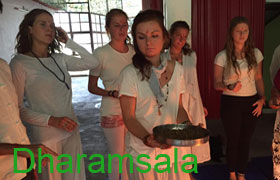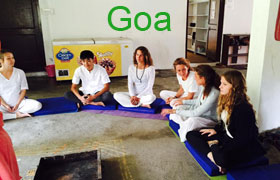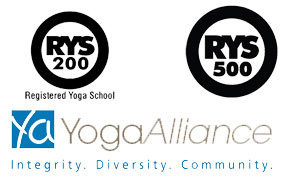Asanas Based on the Strength of Spine
Merudandasana
Merudanda means spine. Spine is the most important part of the human body. Because almost all the nerves of our body are connected to spine such as blood vessels in head, salivary glands, oral and nasal mucosa, skeletal blood vessels, heart, trachea and bronchus, stomach, small and large intestine, kidneys, bladder and genitals.
All these are connected to spine. A person can stay happy, strong, clean and healthy depending on how flexible and stress-free your spine is. Thus a person whose spine is inflexible and stressed will be always prone to health complications because the functionality of all the glands depends upon the flexibility of the spine. Eventually the person is affected by diseases very often. Morning walk is good for health because it aids in the intake of oxygen and improves the blood circulation but does not benefit the spine in anyway. Thus asanas and pranayama prove to be a hundred times more beneficial than walking. Two hours of walking is equivalent to twenty minutes of practice of asana along with ten minutes of pranayama as it gives the same effect on body and mind. Thus practicing merudandasana makes the spine flexible. The following section describes about this asana and various stages of it.
Stage 1
Lie down on your back on the floor and stretch your hands along your shoulder line and turn your palms facing ground. Now place the right ankle in the space between the toes of your left feet. Now bend your right leg towards the left side and try to make your right leg toes touch the ground. Simultaneously, turn your neck and head to the right side (in opposition to your leg movement) but do not allow your hands to move from the initial position. This is the final position of this stage. You can pause in this posture for fifteen to thirty seconds. Then gradually get back to normal state and repeat on the other side too.
Stage 2
Similar to stage 1 you should stretch your hands along your shoulder line and place your palms facing the ground. Now bend your right leg at your knee and place sole of your right leg on the knee of your left leg. Slowly move your right knee towards your left and try to place it on the ground and turn your head and neck towards your right side. Stay in this posture for a while and gradually get back to the normal state. Repeat the procedure on the other side.
Stage 3
In this stage you should fold both of your legs at your knees and place your ankles near your butts. Then turn both your knees towards your left side. Simultaneously turn your neck head towards your right side without moving your hands. Pause in this posture for a while and gradually get back to the normal state. Repeat the same procedure on the other side.
Stage 4
In this also you should fold both of your legs at your knees and your ankles should be placed near your butts. Your knees should be facing upwards. Now move both your legs apart so that are one feet distant from each other. Now try to turn both your legs towards your left side without disturbing the distance between them. Simultaneously turn your neck and head towards your right side. Pause in this posture for a while and gradually get back to the original state. Repeat the same procedure on the other side.
Stage 5
Fold your legs at your knees and bring your thighs on to your stomach. Now turn your knees along with your waist towards your left side. Simultaneously turn your neck and head towards your right side. Pause in this ate for a while and get back to the normal state gradually. Repeat the same procedure on the other side.
Stage 6
In this stage you should slowly raise your right leg such that it is perpendicular to the floor. Now move it towards your left side such that the thigh of your right leg is over your leg and your right feet on the floor. Also turn your head and neck towards your right side. Pause in this state for a while and gradually get back to the normal state. Repeat the same procedure on the other side too.
Stage 7
Raise both of your legs gradually such that they are perpendicular to the floor. Then move both of them towards your left side. Turn your head and neck towards your right side. Pause in this state for a while and gradually get back to the normal state. Repeat the same procedure on other side too.
Precautions
These tips of care should be held in mind while practicing the advanced postures of merudandasana. You should not force yourself to get to the final stage of the posture. They should not be practiced under pressure or hurry. If your spinal cord is not sufficiently flexible, you should practice with utmost care. People who have undergone a surgery in their spine should not practice this asana.
Benefits
This asana makes your spinal cord flexible. It promotes the functionality of the glands in the spine too. It is highly beneficial for sciatica, spondylitis and lumber.
Stage 8
1. Stretch your hands along your shoulder line like in earlier stages. Fold one leg over the other like in garudasana mode.
2. Simultaneously turn your legs to left and head towards your right.
3. Then turn your legs to right and you head towards your left side.
The yoga teacher training in Hrishikesh is the best for learning special yoga asanas that benefit your spine.
Shupt tadasana (stretching)
First of all you should lie down on your back on the floor. Raise your hands upwards and lock your finger behind your head. Now stretch your body along it length. Now turn to your left and stretch. Then turn to right and stretch.
Benefits
The body will no more feel the laziness. Both mind and body will be fresh and active.
Ardha Halasana
It is essential to start with another initial posture in order to practice ardha halasana.
Procedure
1. Lie down on the floor keeping your hands besides.
2. Now gradually raise your left leg to 300, then to 600 and then upto 900.
3. Now slowly drop it down to 600, then to 300 and then on to the floor.
4. Repeat the same with the other leg too.
5. When you have practiced well with single leg, you can try to do it with both legs. Raise both your legs gradually to 300, then to 600 and then upto 900. Pause in this state for a while. Now slowly drop them down to 600, then to 300 and then on to the floor. You can now relax in shavasana.
Precautions
People suffering with sciatica, lumbar, spondylitis and pregnant ladies should not practice this asana.
Benefits
1. Strengthens the abdominal muscles.
2. Improves the efficiency of digestive system.
3. Helpful for people suffering with diabetes, constipation, indigestion and weakness of nerves.
4. Thighs and calf muscles are strengthened.
5. Beneficial for pelvic joint also.




